How Hank Green's Focus Friend App is Winning Hearts (and Ratings)
Published 3rd September, 2025 by Claire McGregor If you’ve been anywhere near the productivity or creator economy corners of the internet lately, you’ve probably seen Focus Friend popping up on social feeds. Created by author and YouTuber Hank Green, the app has quickly climbed the charts in the U.S. to hit number one in Productivity, briefly overtaking ChatGPT in the number one spot. The ratings and review data tells us exactly why. At Appbot, we love digging into the data behind virality, user love, and those inevitable pain points that every app faces along the way. Here’s what the Focus Friend story looks like so far.
If you’ve been anywhere near the productivity or creator economy corners of the internet lately, you’ve probably seen Focus Friend popping up on social feeds. Created by author and YouTuber Hank Green, the app has quickly climbed the charts in the U.S. to hit number one in Productivity, briefly overtaking ChatGPT in the number one spot. The ratings and review data tells us exactly why. At Appbot, we love digging into the data behind virality, user love, and those inevitable pain points that every app faces along the way. Here’s what the Focus Friend story looks like so far. What we cover:
- Meet Your Focus Friend: Bean
- Early Ratings Show Strong Momentum
- Beyond the Stars: What Users Are Saying
- Ratings vs Review Ratio
- App Review Comparison: iOS vs Android at a Glance
- How Users Feel About Focus Friend - Emotion Analysis
- Behind the Buzz: Key App Review Takeaways
- Why Focus Friend Went Viral
- Why it Resonates with Users
- Standing Out in a Crowded Market
Want to monitor & track your app reviews?
Try Appbot free now, no credit card needed →Meet Your Focus Friend: Bean

Focus Friend by Hank Green is a delightfully cozy, gamified productivity timer. Users set a timer, and their cheerful little “Bean” knits socks and scarves while they stay focused. Successfully completed sessions earn decorative items for the Bean’s room, while unlocking Deep Focus Mode, Break Timers, and Live Activity features (especially on iOS) to help users block distractions and stay in the zone. The app leans heavily on whimsical comfort and fun rather than punitive screen-time locks.
Early Ratings Show Strong Momentum
App ratings are crucial to the success of an app. They influence the app store search rankings, shape first impressions, and drive conversions which in turn affects everything from downloads to in-app purchases. Users rely on both the volume and average rating to decided whether an app is worth their time and money.
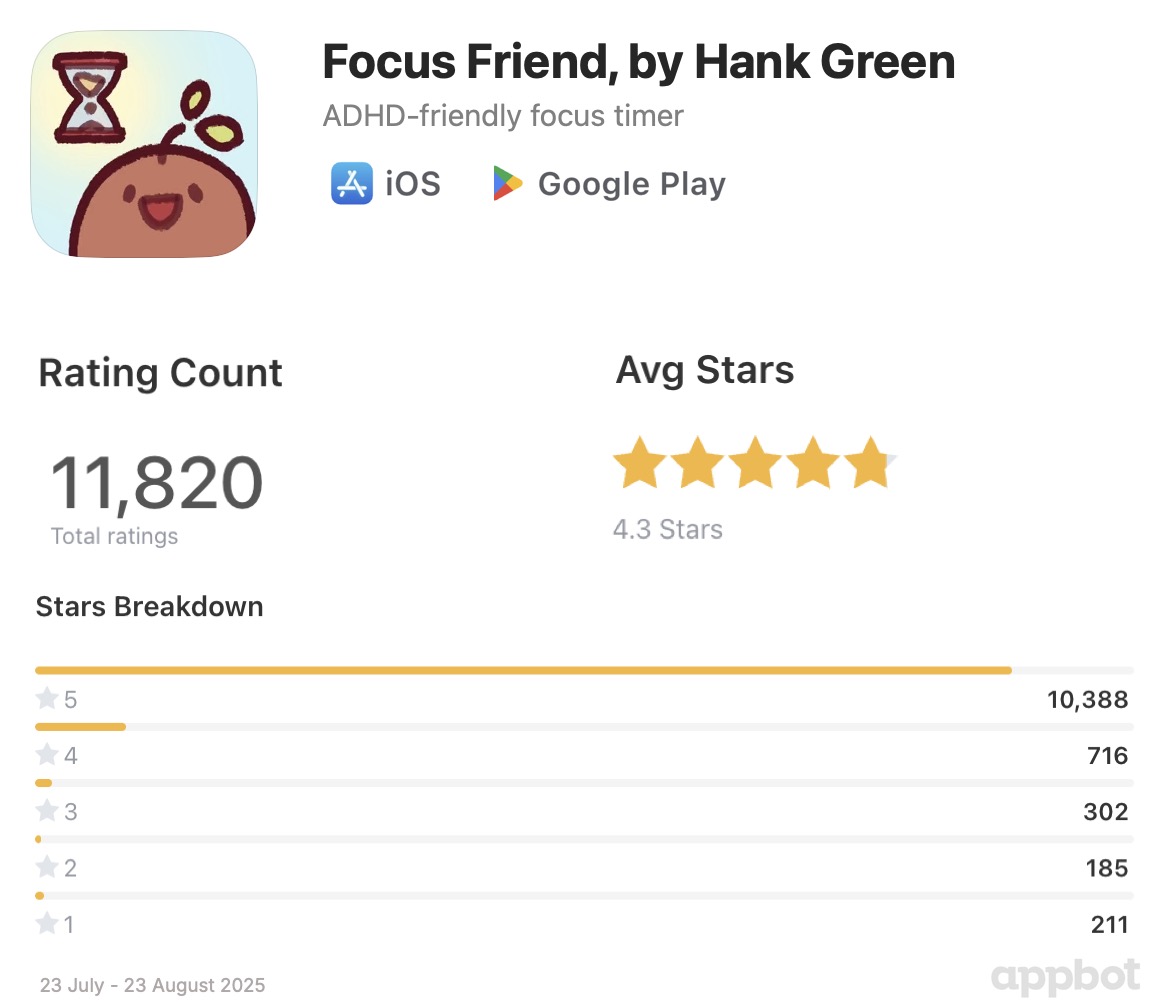
The Focus Friend apps were launched in the Google Play and Apple Store on 23 July 2025. In just one month, the app across both app stores has received an impressive total ratings of 11,820 with an average star rating of 4.3.
Let’s take a closer look at how Focus Friend is performing in both the Apple App Store and Google Play Store ratings after its first month live.
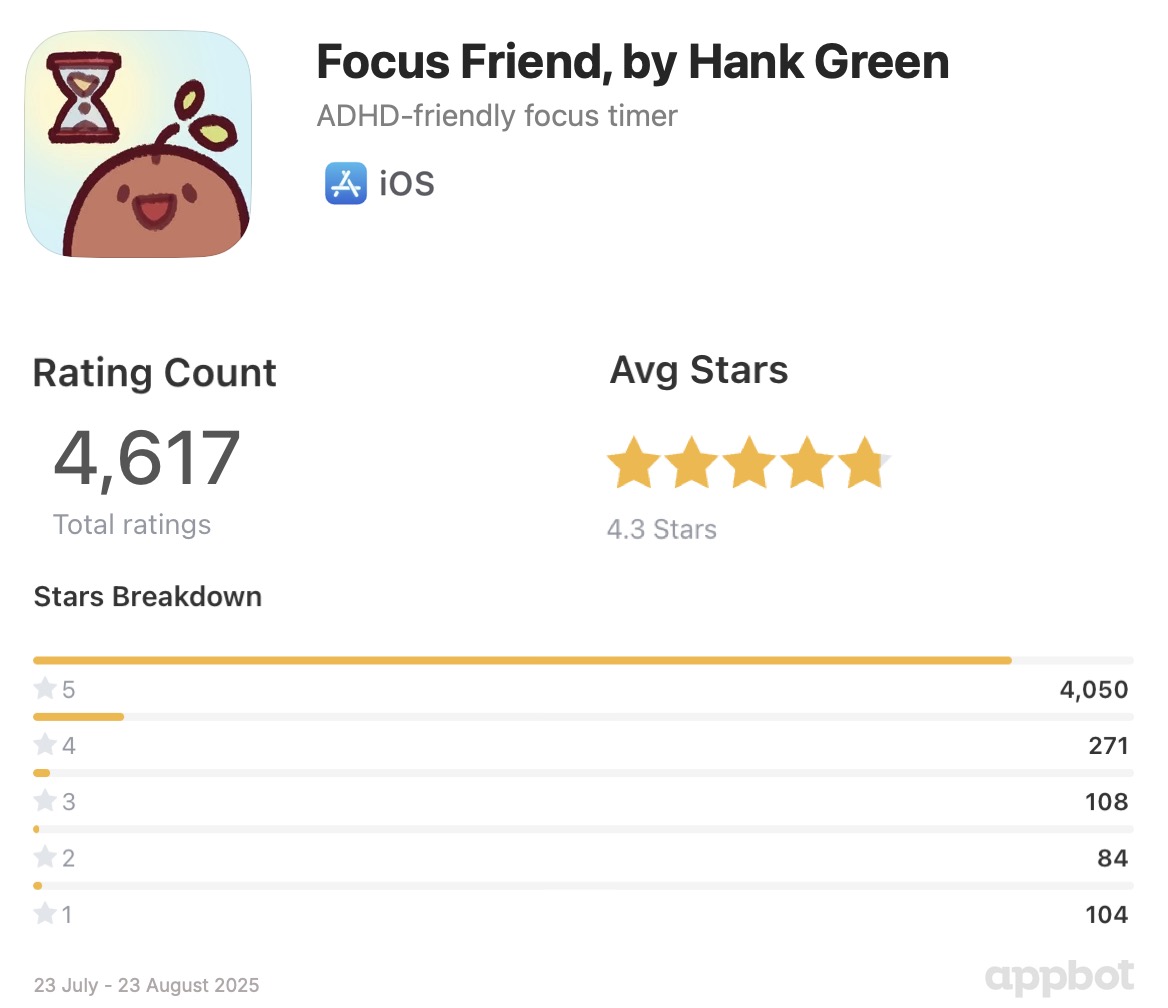
The iOS app has received 4,617 ratings, with an average star rating of 4.3 stars.
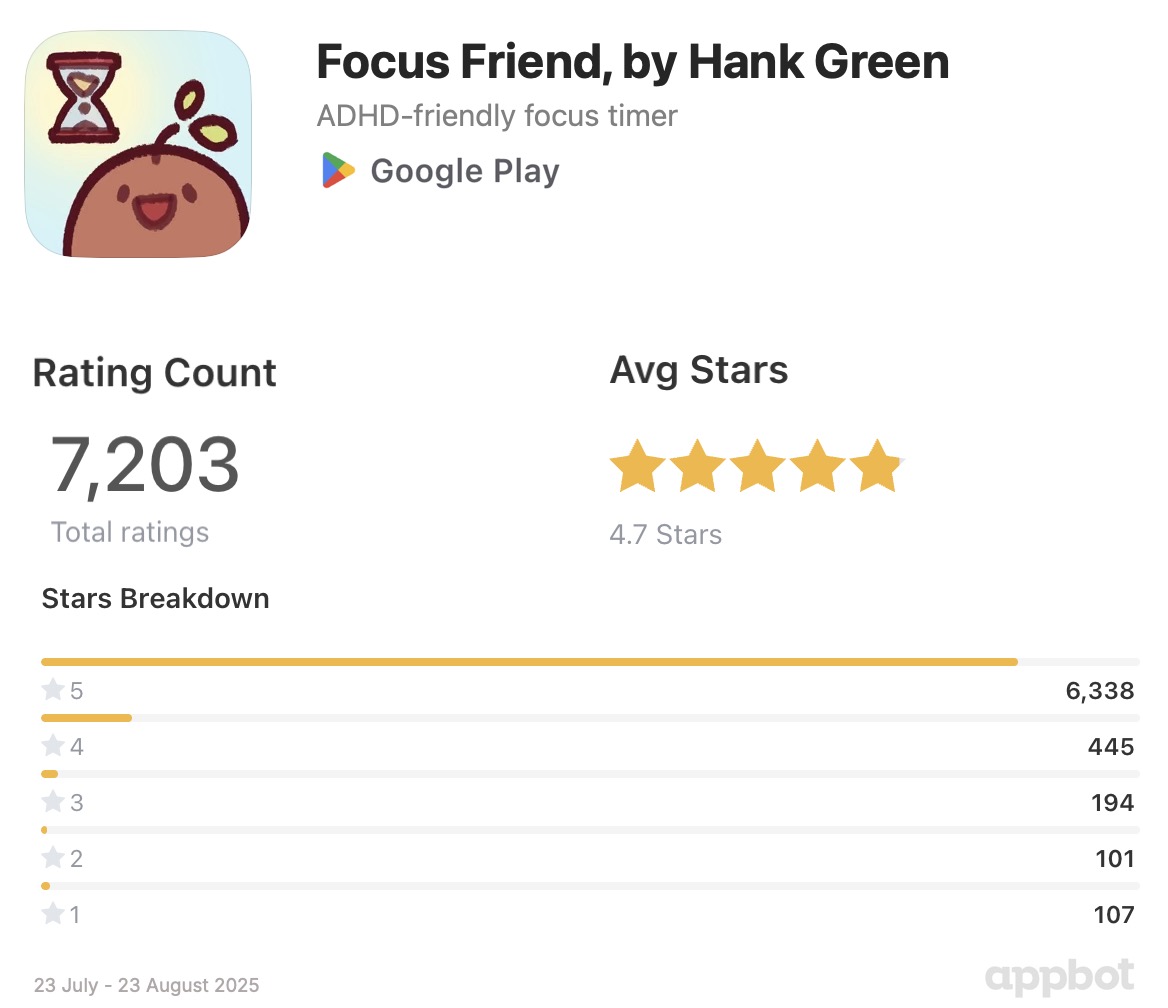
The android app has 7,203 ratings, with an average star rating of 4.7 stars.
Where the Ratings Differ (Just Slightly)
When comparing ratings across platforms, one of the first things that stands out is volume: Google Play users left more ratings overall 7,203 compared to 4,617 on iOS. At first glance, you might expect that bigger pool of feedback to produce different patterns, but the star rating breakdowns are surprisingly consistent.
On both platforms, nearly 9 out of 10 reviews are 5 stars. This overwhelming positivity makes it clear that users are not just downloading the app, but genuinely delighted with it. The mid-range (3 and 4 star reviews) accounts for only about 8 - 9% of ratings on either platform, while negative reviews (1 - 2 stars) remain very small in proportion.
| Platform | Total Ratings | 1 star | 2 stars | 3 stars | 4 stars | 5 stars |
|---|---|---|---|---|---|---|
| iOS | 4,617 | 2.3% | 1.8% | 2.3% | 5.9% | 87.7% |
| 7,203 | 1.5% | 1.4% | 2.7% | 6.2% | 88.0% |
The only noticeable difference is that iOS users were slightly more likely to leave 1 and 2 star reviews. This suggests a small pocket of dissatisfaction that surfaces more clearly on iOS, while Google ratings trend just a touch higher. Overall, though, the message is consistent: regardless of where users come from, the ratings show that the experience is strong and widely appreciated.
Beyond the Stars: What Users Are Saying
App reviews deliver deeper insights and they help surface bugs, ideas, and highlight where users are delighted or frustrated. Across both apps there has been 2,141 app reviews with an average star rating of 4.4 stars.

The iOS app has received 910 app reviews with an average star rating of 4.3 stars.
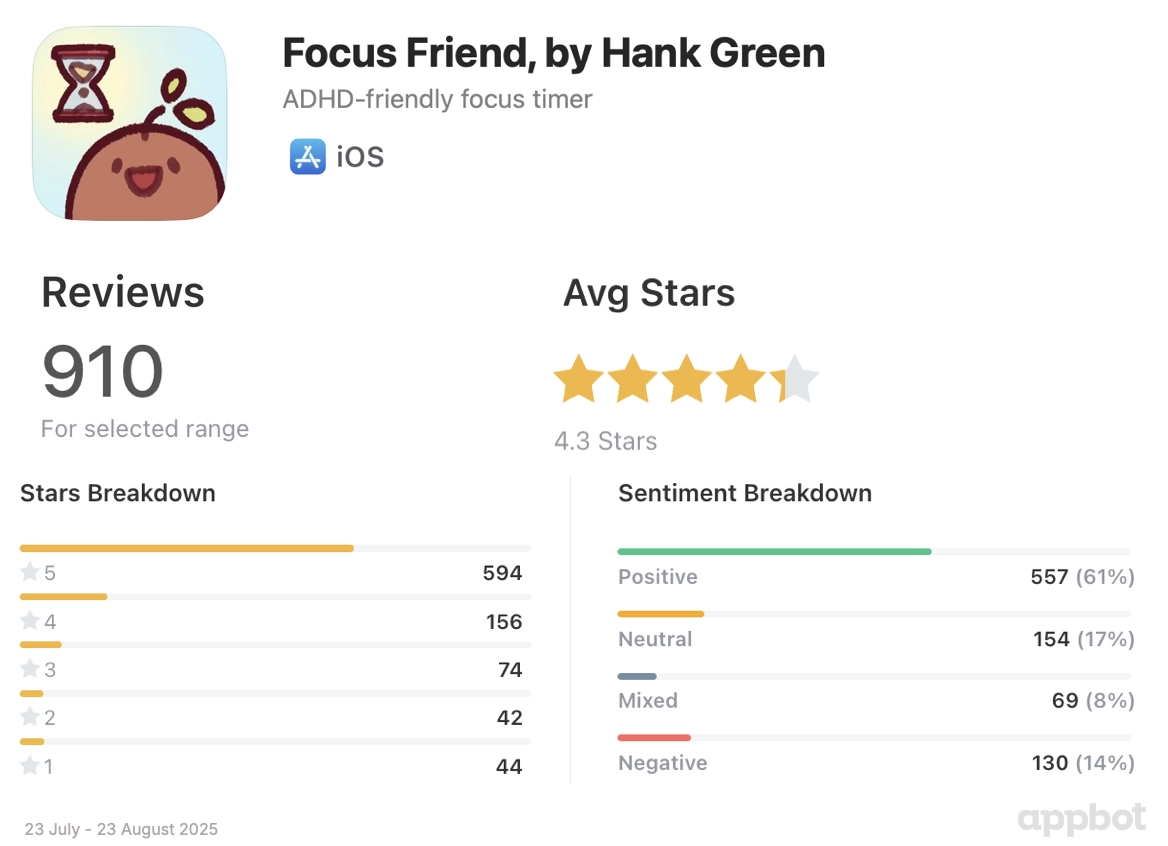
The Android app has received 1,330 app reviews with an average stars 4.4 stars.
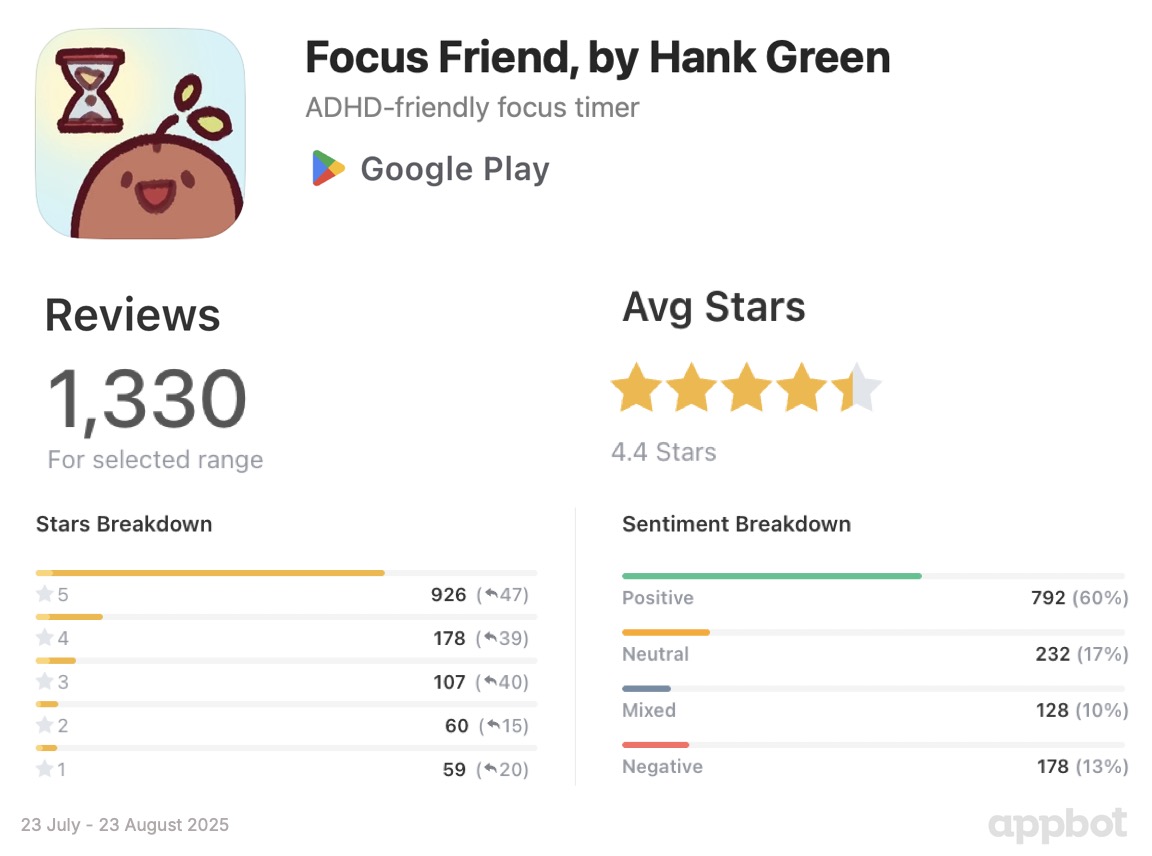
iOS vs Android: What the App Review Numbers Reveal
Understanding user feedback across platforms isn’t just about star ratings, it reflects different user expectations, habits, and preferences. iOS and Android users often interact with apps differently, from how they write reviews to what they care most about.
The iOS app has received 910 reviews with an average rating of 4.3 stars, indicating generally positive feedback but with room for improvement. This slightly lower rating compared with android users, may reflect more critical feedback from iOS users or differences in expectations around design and performance on Apple devices. Additionally, the lower number of reviews suggests slightly lower engagement or fewer prompts for feedback on the App Store.
In contrast, the Google Play app has attracted 1,330 reviews, showing stronger user engagement on Android. With an average rating of 4.4 stars, Android users appear to be marginally more satisfied overall. This could reflect a smoother user experience on Android devices, more effective onboarding, or greater alignment with Android user expectations.
Overall, while both platforms show high satisfaction, the Google Play Store has a larger and slightly more enthusiastic reviewer base, offering a broader pool of feedback for future updates and improvements.
Ratings vs Review Ratio
One of the most revealing metrics in app store analytics isn’t just the star rating, it’s the ratio of reviews to ratings. While tens of thousands might leave a star rating with a tap, far fewer take the time to write a review. For Focus Friend, this ratio is striking.
Across iOS and Google Play combined, the app received 11,820 ratings in its first month, an impressive start. But what’s even more remarkable is that 2,346 of those users also wrote detailed reviews. That’s a review-to-rating ratio of 19.85%, nearly four times higher than the average (typically around 5%).
This elevated ratio isn’t just a vanity metric, it’s a powerful signal of user engagement and emotional investment. Users aren’t just passively enjoying the app; they care enough to share thoughtful feedback, praise, and even bug reports or feature ideas. In a market where attention is scarce, this level of active participation highlights Focus Friend’s unique ability to connect with its audience on a deeper level.
App Review Comparison: iOS vs Android at a Glance

When comparing app reviews for Focus Friend across iOS and Google Play, a clear and consistent trend emerges. The app’s launch triggered a sharp spike in reviews on both platforms, fueled by media coverage, social media buzz, and support from high-profile creators. This initial momentum drove a wave of early user engagement, with Google Play ultimately generating a higher volume of reviews than iOS.
The average star rating is comparable, 4.4 on Google Play and 4.3 on iOS, suggesting a broadly positive reception on both platforms. The Sentiment score reveals near parity, with Google scoring 88 and iOS closely behind at 87. This consistency reinforces the app’s appeal across device ecosystems.
But star ratings and review counts only tell part of the story. To truly understand why users are connecting with Focus Friend and where there’s room to improve, we need to look beyond the numbers. That’s where qualitative analysis comes in. By diving into the emotional tone, sentiment, and recurring themes within user reviews, we can uncover what users are really saying. From joy and gratitude to bug reports and feature requests, we reveal the deeper layers of user feedback driving Focus Friend’s success.
How Users Feel About Focus Friend - Emotion Analysis
Appbot's Emotion Visualizer provides a unique lens into how users feel, not just what they say. When comparing Google and iOS app reviews, both platforms reveal a strong cluster of green (positive) emotions on the “pleased” and “passive” side of the spectrum. This suggests a generally satisfied user base on both stores.
iOS App Reviews Emotion Visualizer
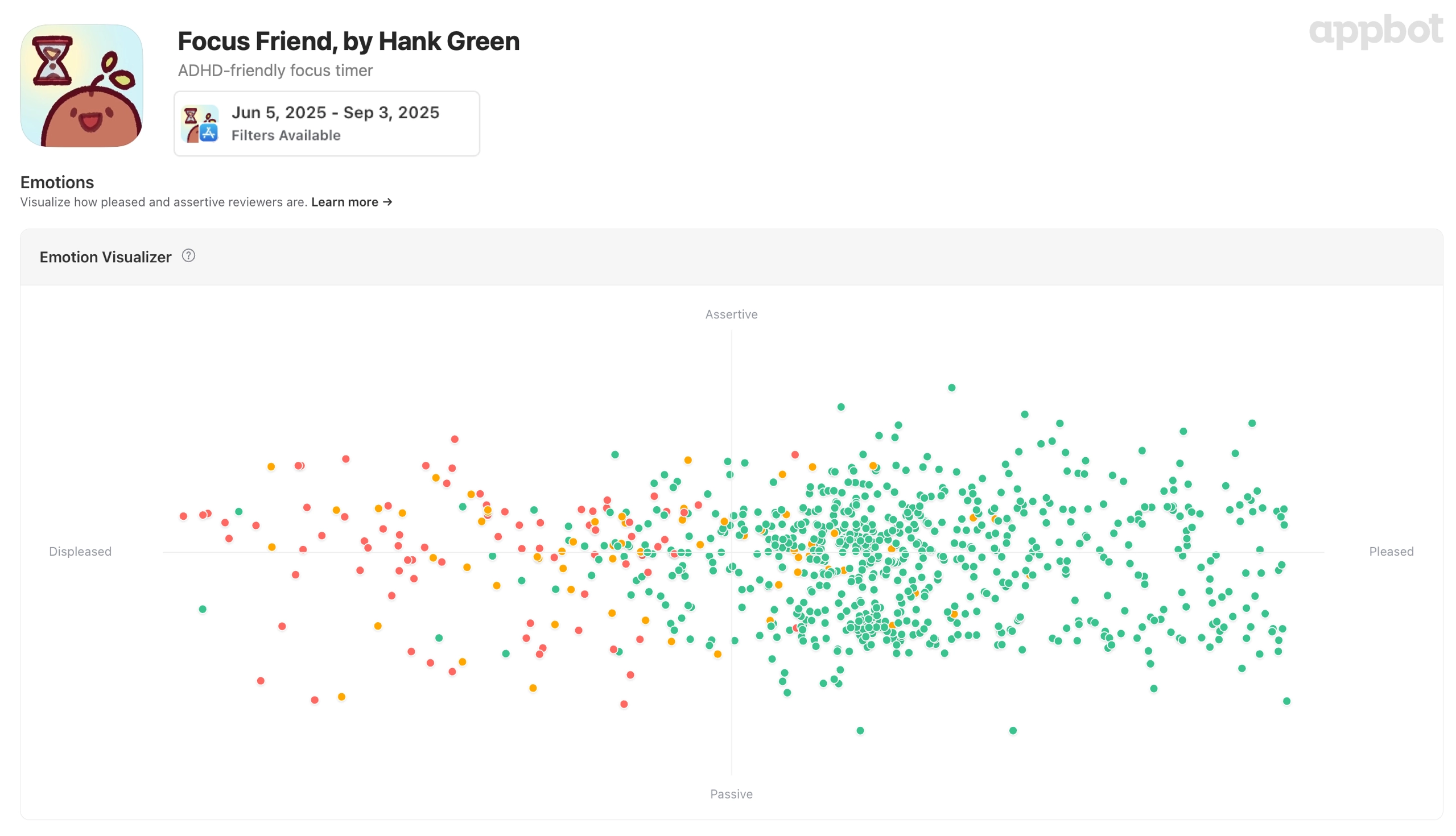
The emotion analysis for iOS reviews of Focus Friend displays a broader emotional spectrum compared to Google Play. While a strong majority of reviewers fall within the “Pleased” zone, especially in the passive quadrant, there is a noticeably higher concentration of displeased reviews. These include both passive complaints and more assertive negative feedback, suggesting that iOS users may be slightly more vocal about issues or unmet expectations. Still, the green cluster on the right dominates the chart, indicating that most users are happy with the app, but iOS users express a wider emotional range overall.
Google App Reviews Emotion Visualizer
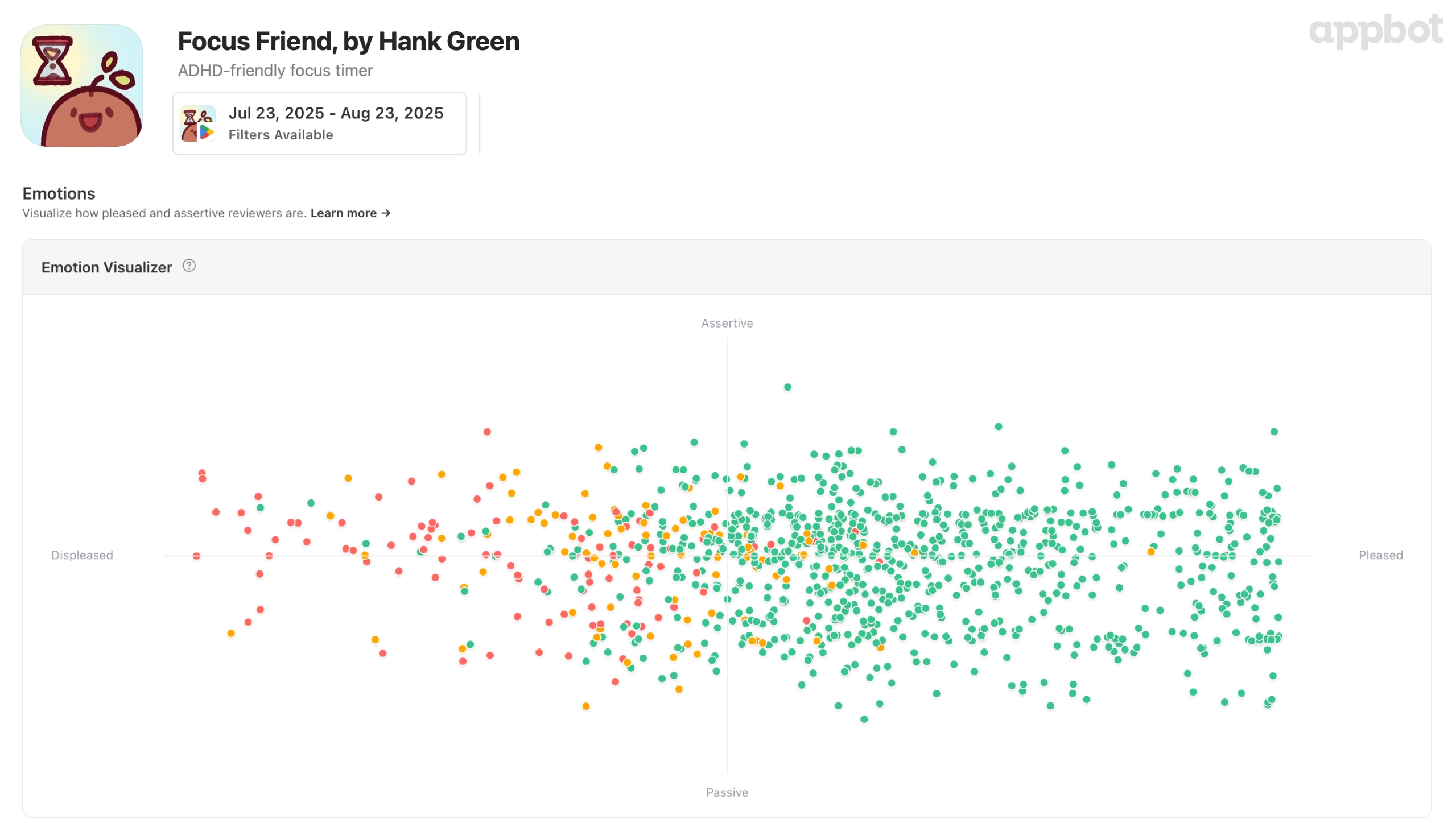
The emotion analysis for Google Play reviews of Focus Friend reveals a predominantly positive emotional response. The majority of reviews cluster in the “Pleased” and “Passive” quadrant, indicating users are generally happy and content without expressing strong assertiveness. There are fewer reviews in the “Displeased” half of the graph, with a noticeable drop-off in both assertive and highly negative feedback. A handful of assertive and displeased reviews are visible, but they are clearly outweighed by the positive sentiment, showcasing an emotionally satisfied and loyal user base.
Understanding the Mood: Sentiment Analysis
What makes sentiment analysis so powerful is its ability to capture nuance. Users aren’t just leaving high star ratings, they’re expressing genuine appreciation for the app’s tone, mission, and experience. It’s not just what the app does, but how it makes them feel. At the same time, mixed, neutral, and even negative reviews often reveal a deeper layer, many users love the concept but are frustrated with early bugs, missing features, or design quirks. These reviews still reflect engagement and emotional investment, offering valuable clues for where the experience can be improved.
Since launch, Focus Friend has received overwhelmingly positive sentiment across both iOS and Google Play. The majority of reviews fall into positive or mixed-but-encouraging categories, reinforcing that this isn’t just a well-rated app, it’s one that resonates emotionally. And when it comes to long-term success, that emotional resonance can be everything. Sentiment reflects not just high star ratings, but also the tone and emotion of written reviews, which is often a more telling measure of true user delight.
iOS App Review Sentiment

On iOS, reviews are broadly enthusiastic. 61.3% of all written feedback is positive, with many users commenting on the emotional resonance of the app, calling it “kind,” “encouraging,” and “funny.” While the positivity rate is high, iOS also sees a slightly elevated 14.9% negative sentiment, which reflects some early-version bugs or feature limitations mentioned in feedback.
Interestingly, mixed sentiment for iOS app reviews sits lower at just 6.9%, which suggests that when users do take the time to write a review, they tend to have more strongly formed opinions.
Google App Review Sentiment
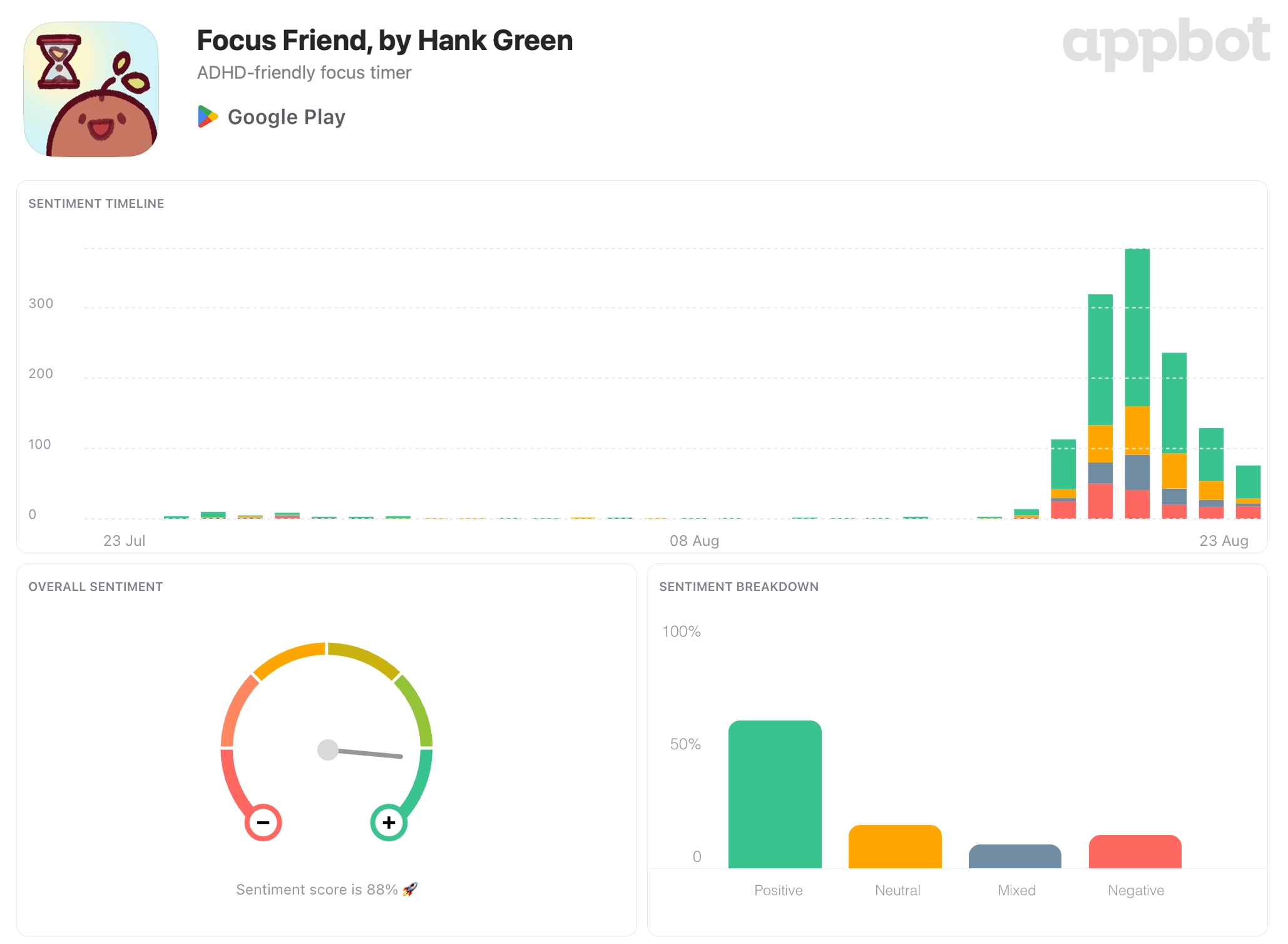
Google Play paints a similar picture, with 59.5% of reviews being positive. The overall tone of feedback is highly supportive, with many Android users appreciating the app’s ADHD-friendly approach and gentle design. However, Google users show slightly more mixed (9.6%) and neutral (17.4%) sentiment, indicating a broader spread of experiences, potentially due to the variety of Android devices and configurations.
The negative sentiment rate of 13.4% is slightly lower than iOS, reinforcing the idea that while Android users may be more varied in feedback tone, they’re less harsh when it comes to criticisms.
Comparing iOS and Google Sentiment
| Platform | Positive | Neutral | Mixed | Negative |
|---|---|---|---|---|
| 59.5% | 17.4% | 9.6% | 13.4% | |
| iOS | 61.3% | 16.9% | 6.9% | 14.9% |
Sentiment is remarkably consistent across platforms, with both showing a clear majority of positive reviews. iOS edges slightly higher in positivity (61.3% vs. 59.5%) and has fewer mixed reviews, while Google has a slightly lower share of negative sentiment (13.4% vs. 14.9%). Despite these small differences, the overall picture is one of alignment: users on both platforms not only enjoy the app but also share feedback in a gentle, supportive tone. This suggests that Focus Friend’s emotional appeal and community-driven ethos resonate equally with iOS and Android audiences.
Behind the Buzz: Key App Review Takeaways
To understand what’s driving FocusFriend’s surge in popularity, we used Appbot's automated text analysis tool, Topics, to analyse all app reviews across iOS and Google Play. This helped us uncover not just what users are feeling, but why. From delight in the app’s design to requests for new features, here are the top themes that keep showing up.
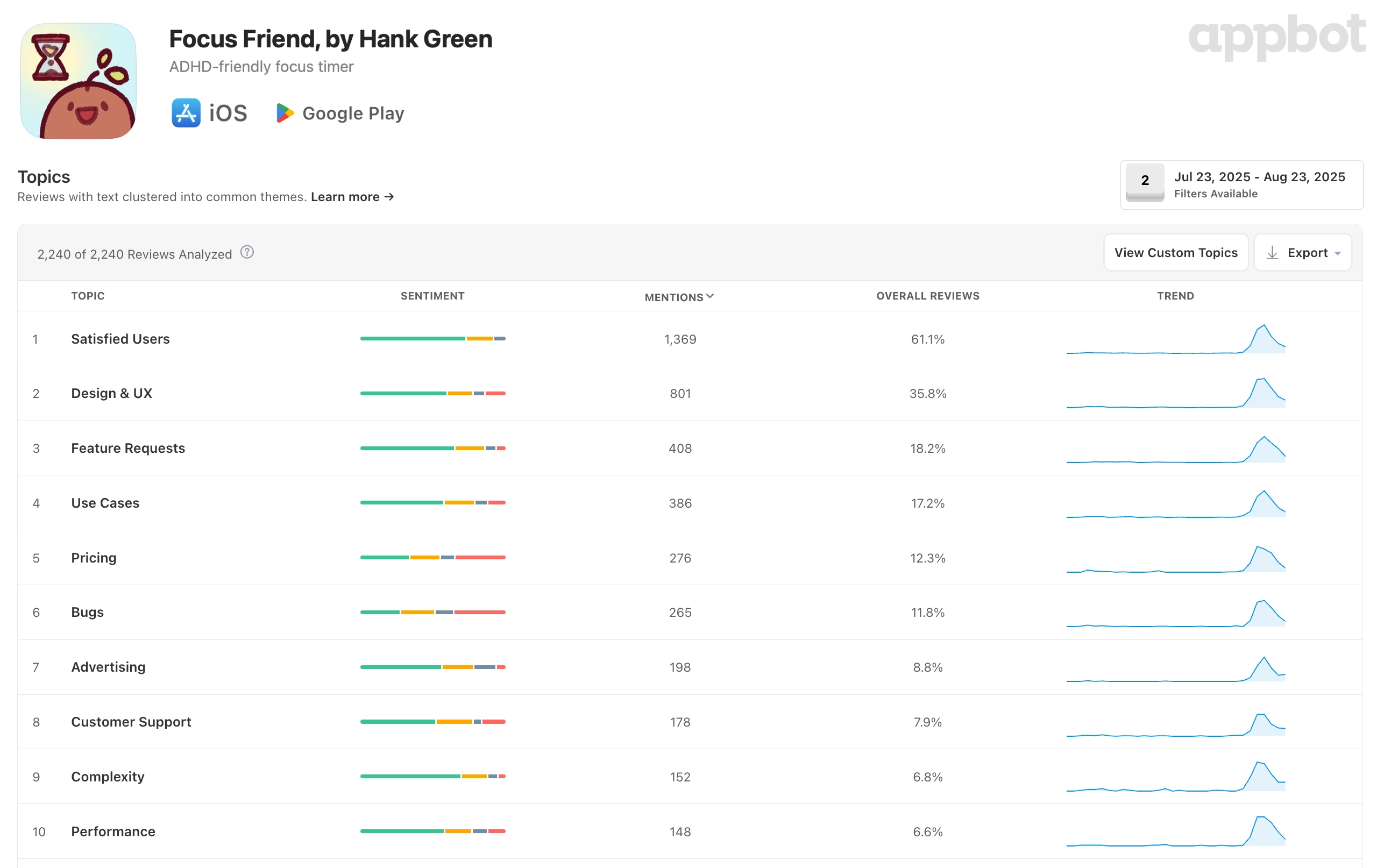
Let's dig deeper into some of the top app review themes for the Focus Friend apps in its first month:
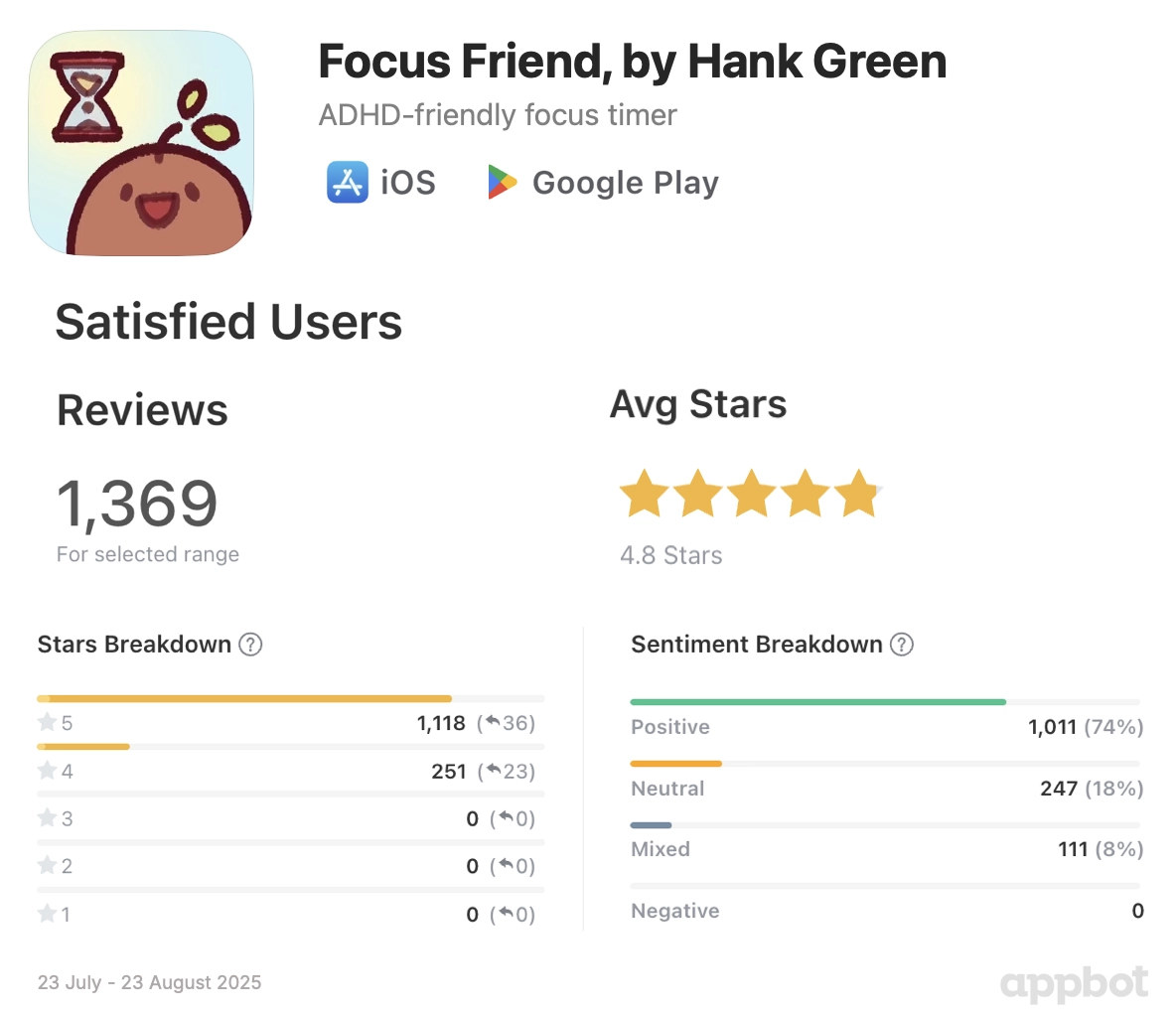
The top theme across both platforms was Satisfied Users, making up 1,369 reviews or 61.1% of all review feedback in the first month. While often overlooked, this group provides especially valuable insights into what’s working well and where improvements could be made. . These feedback in this reviews are often more nuanced than a simple five or four star rating, pointing to the features, tone, and experience that drive long-term loyalty.
Importantly, satisfied doesn’t always mean uncritical. Many of these reviews had neutral or mixed sentiment, flagging minor issues, even while awarding 4 or 5 stars. Users also often praised the app overall, while pointing out missing features or desired improvements.This shows users are engaged and invested enough to want the app to get better, a good signal for retention and loyalty.
When we break it down by platform, the split is relatively balanced:
- iOS: had 593 satisfied user reviews (65.2% of all iOS reviews) with an average star rating of 4.8
- Google Play: had 776 (58.3% of all Google Play reviews) with an average star rating of 4.8
This suggests that iOS users were slightly more likely to express overall satisfaction, despite writing fewer reviews in total. On the other hand, Google Play’s larger review volume delivered a broader cross-section of feedback, reinforcing the strength of Focus Friend’s appeal across different device ecosystems.
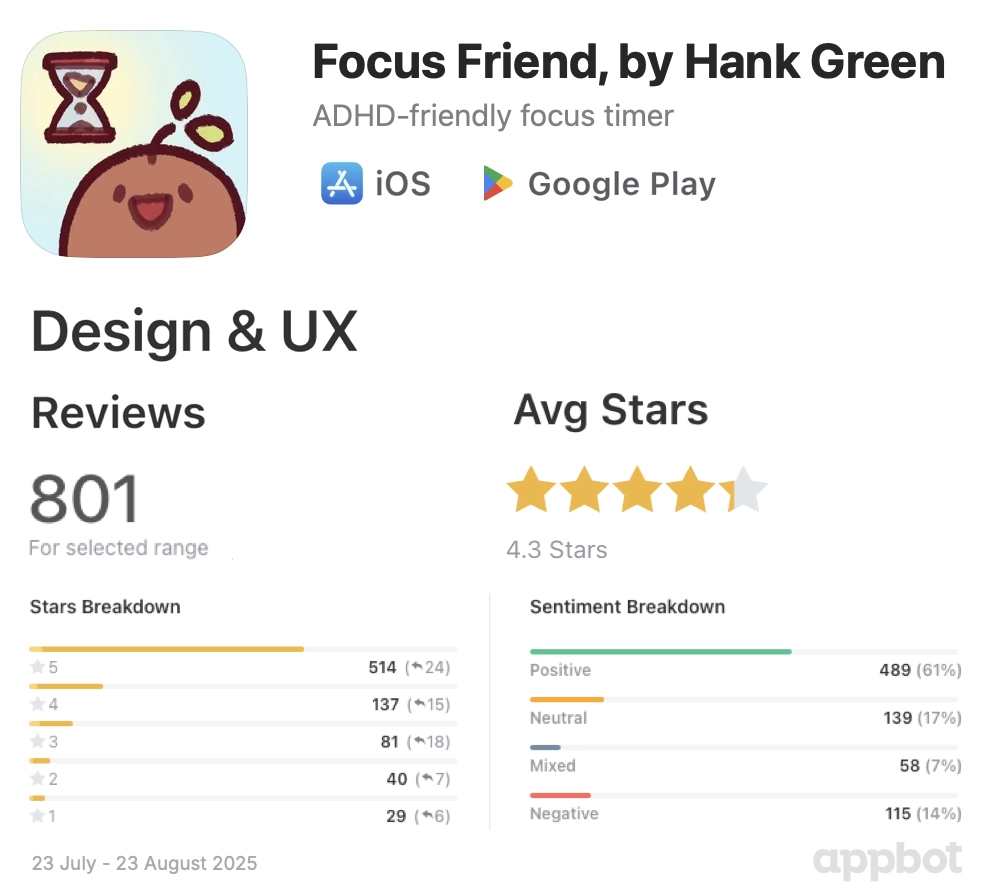
Design and UX were mentioned in 801 reviews, making this one of the second most frequently discussed topic. Overall, users rated these reviews highly, with an average star rating of 4.3 stars, placing UX & Design as a core strength of the app.
The sentiment breakdown shows a strong lean towards positivity:
- 511 positive reviews praised the design, usability, and overall aesthetic.
- 141 neutral reviews acknowledged the design without strong praise or critique.
- 119 negative reviews flagged pain points where the design felt unintuitive or confusing.
- 59 mixed reviews combined appreciation with constructive feedback about the UX.
Ratings strongly reflected this divide. Positive mentions averaged 4.8 stars, while negative mentions dropped to just 2.2 stars. Mixed and neutral reviews still leaned high at 4.4 stars, reinforcing that most users view the design favorably even when offering suggestions.
Notably, feedback was consistent across platforms:
- Google Play: 440 mentions and an average rating 4.1.
- iOS: 390 mentions and an average rating 4.3.
This parity suggests that both iOS and Android users perceive the app’s design quality similarly, a strong indicator of cohesive cross-platform UX.
In short, UX & Design are clear differentiators for Focus Friend. Positive sentiment makes it a delight factor, while the critical feedback highlights opportunities to refine navigation and interaction patterns. By addressing those edge cases, the app could transform good impressions into great ones, sustaining its high ratings.
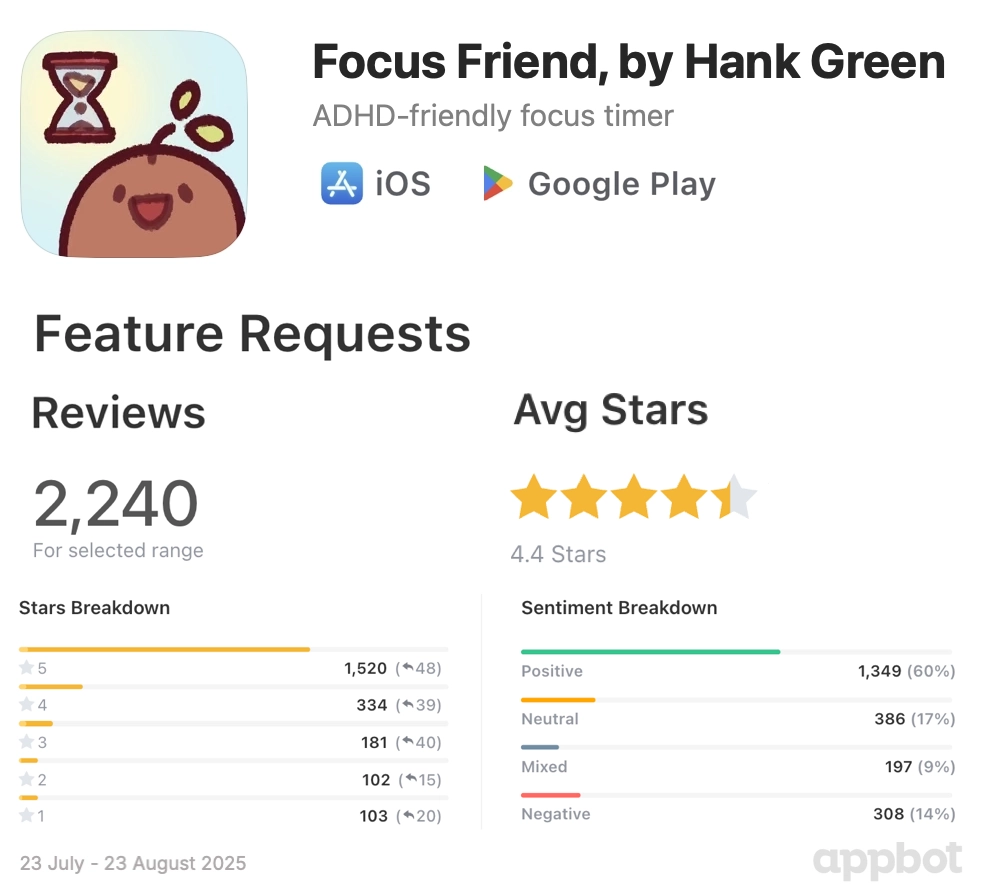
Users are actively shaping the future of Focus Friend through feature request reviews, which appeared in 426 mentions across both app stores. These reviews carried a strong average rating of 4.4, showing that requests typically come from users who are already engaged and supportive of the app.
The sentiment distribution highlights this enthusiasm:
- 285 positive reviews praised the app while suggesting new ideas.
- 84 neutral reviews made straightforward requests without attaching strong emotions.
- 31 mixed reviews paired compliments with constructive suggestions.
- Just 26 negative reviews expressed frustration at missing functionality.
Ratings followed this pattern closely. Positive request reviews averaged 4.7 stars, and even neutral or mixed mentions stayed above 4.3 stars. Negative requests, however, fell sharply to 2.2 stars, showing that when missing features are critical to a user’s workflow, the impact on satisfaction is significant.
Feature requests came evenly from both platforms:
- Google Play: 214 reviews with an average rating of 4.3.
- iOS: 212 reviews with an average rating of 4.4.
This balance suggests that the desire for new functionality is platform-agnostic and reflects a shared vision from the user base.
Overall, feature request reviews reveal a highly engaged community: most users are happy but hungry for more. This is a promising signal, since it shows users see long-term value in the app and are eager to invest in its evolution. The key challenge for the product team is to prioritize requests effectively so that the most impactful improvements can turn loyal users into advocates.
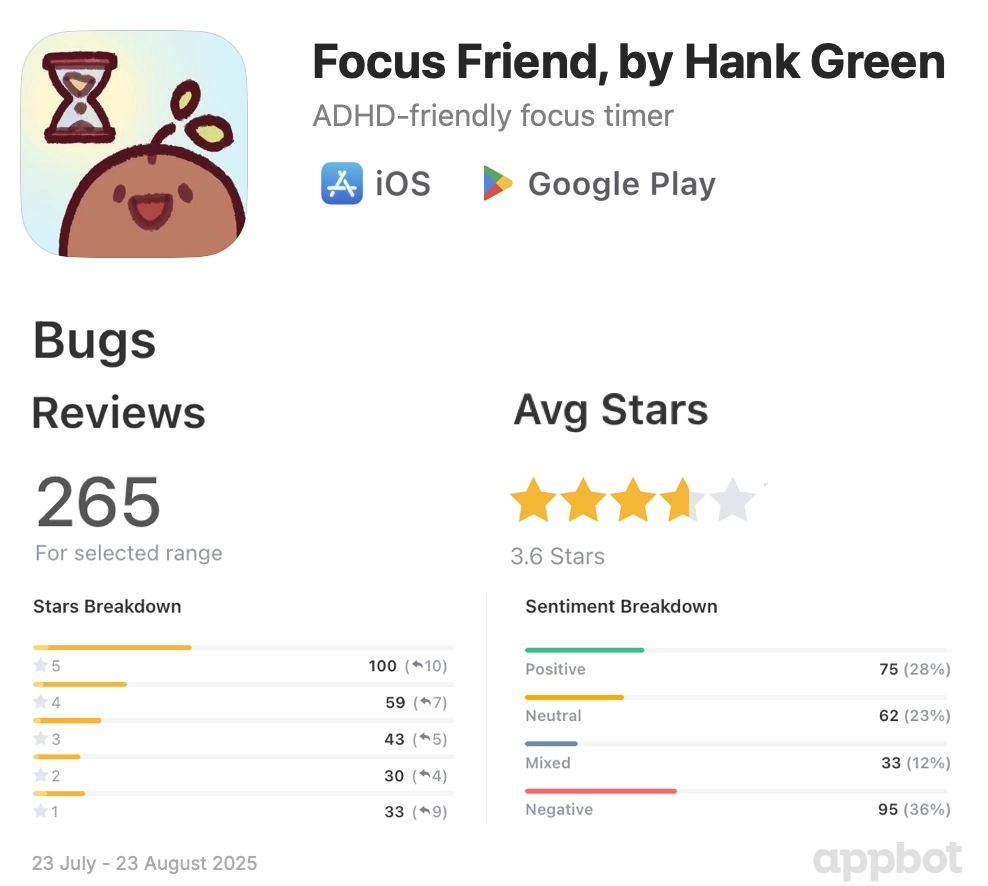
While the overall reception of Focus Friend has been overwhelmingly positive, about 12.5% of all reviews (267 out of 2,141) mention bugs or technical issues. Common phrases found in these reviews include complaints about the app freezing, not loading properly, or unexpectedly crashing. Several users also mention issues with the app’s “bean” tracking, hinting at a potential pain point in one of the core features.
Interestingly, not all bug-related reviews are negative. Some users note minor glitches but still leave positive star ratings, praising the concept, design, or overall utility of the app despite the technical hiccups. This suggests strong user goodwill and a willingness to overlook small issues when the core experience is valuable.
Despite the high volume of downloads and attention, the proportion of bug-related complaints remains relatively modest. However, these issues offer valuable direction for the next wave of app improvements, especially if they affect core functionality like focus tracking or task completion.
When comparing platforms for app reviews about bugs, the picture is remarkably consistent:
- iOS:142 reviews mention bugs, with an average rating of 3.5.
- Google Play:125 reviews mention bugs, with an average rating of 3.7.
This consistency suggests that the technical issues are not isolated to one platform, but are likely related to shared features or backend services. Despite the bugs, many users on both platforms still rated the app above 3 stars, indicating that they see value in the core experience even when encountering occasional problems.
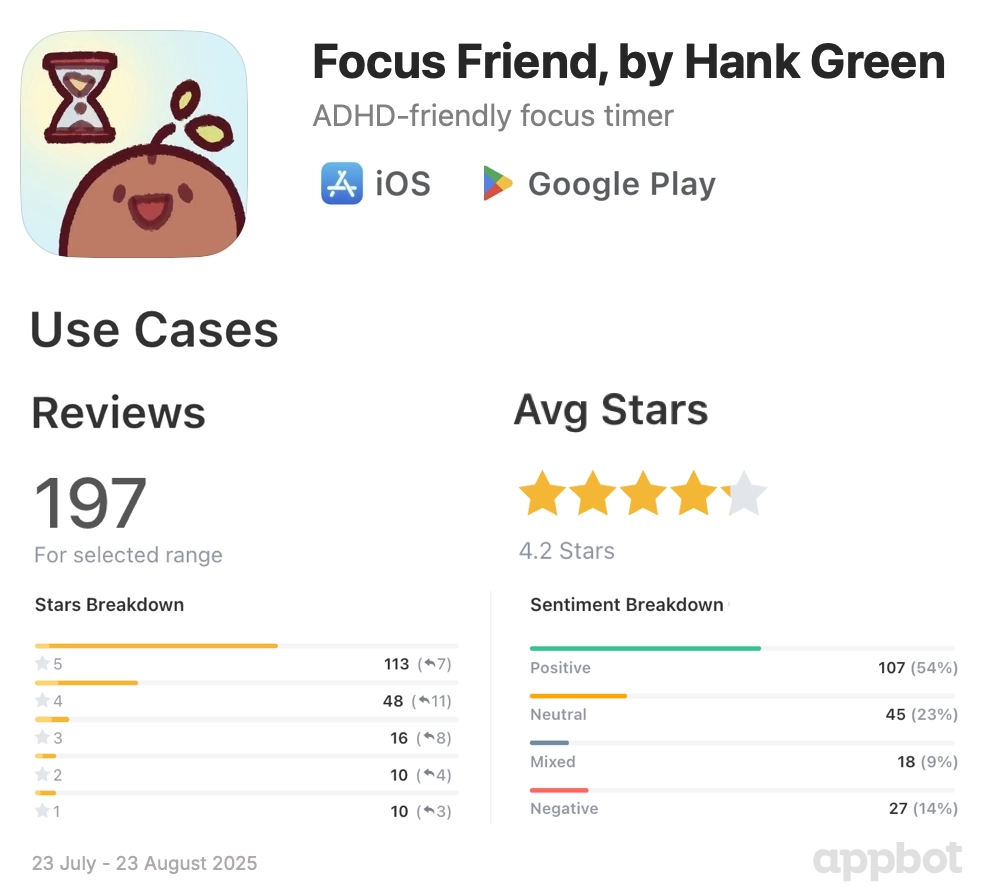
Behind every five-star rating or heartwarming review is a real person with a real reason for using Focus Friend. From the reviews, we can see a wide range of use cases, proof that the app isn’t just novel, it’s genuinely useful across contexts.
Neurodivergent users“I have ADHD and this is the only timer I’ve stuck with. Bean makes me feel like I’m doing a good job, even if I just get started.”
Over 70 app reviews mentioned ADHD or other focus-related neurodiversity challenges consistently highlight how Focus Friend helps them get into the zone without pressure. The calm visuals, lack of punishment for distraction, and soft encouragement resonate deeply with those seeking gentle structure and dopamine-friendly feedback.
Students staying on task“Helps me stay off TikTok while doing homework. Bean is the only reason I passed math this term.”
Students are a clear segment of Focus Friend’s user base, and the reviews reflect this with a total of 36 reviews mentioning it. On iOS, 24 reviews mentioned being a student or studying, compared to 12 on Google Play. That means iOS users were about twice as likely to highlight student-focused use cases. Some mention using it for timed study sessions, essay writing, or exam prep, often alongside physical planners or digital calendars. The gentle visuals and low-pressure approach help make academic tasks feel less overwhelming This suggests that Focus Friend is particularly resonating with iOS’s younger demographic, who may be more likely to use the app for schoolwork and study sessions.
Creatives in the flow“This app helps me write without feeling like I’m in a race. I love the vibe, it keeps me going through my design projects.”
Artists, writers, musicians, and indie creators use Focus Friend to support deep work. The app’s playful design, gamified rewards, and subtle accountability make it easier to enter a creative state without breaking flow. It’s a favorite for solo makers and late-night builders alike.
Remote workers and freelancers“I use this during my work-from-home blocks. It’s my cue to stop scrolling and start working. Even my kid reminds me to check on the Bean.”
Using Focus Friend while working-from-home is mentioned in 7 app reviews. For people juggling meetings, to-dos, and distractions from home, Focus Friend brings much-needed structure. Freelancers and remote employees use it to time work sprints, manage breaks, or create mini-routines, sometimes even turning it into a family or team ritual.
Whether it’s acing an exam, writing a novel, or simply reclaiming calm, users are building their own meaning into each session. And that’s where Focus Friend really shines, it meets people where they are, one knitted sock or scarf at a time.
Use cases aren’t just valuable for product insights, they can also help build targeted marketing materials. By understanding which groups of users are using the app for focus, ADHD support, studying, or productivity, you can tailor messaging that resonates directly with those needs. Highlighting specific features that align with these use cases in ads, app store descriptions, and social content can improve conversion rates and strengthen user loyalty.
Why Focus Friend Went Viral
Focus Friend didn’t just appear, it launched with momentum. It’s no accident that Focus Friend took off so fast. Hank Green’s track record with creator-first ventures like Vlogbrothers, DFTBA Records, and 2D Glasses meant he already had a loyal audience. That foundation of authenticity, creativity, and community meant Hank had an audience primed to adopt Focus Friend from day one. But a built-in fanbase is only part of the story.
What truly fueled the app’s spread was its emotional framing. This isn’t another productivity tool that shames you into working harder, it’s a cozy, whimsical experience that feels kind. That tone, paired with a highly shareable mascot (Bean!) and social media-friendly screenshots, made it effortless for users to recommend it to friends, family, and followers. Reviews frequently mention discovering the app through word of mouth or being shown it by someone they trust.
Why it Resonates with Users
Focus Friend doesn’t just help users get more done, it helps them feel better while doing it. Where many productivity apps lean into pressure and performance, FocusFriend offers warmth, humor, and gentle encouragement. Users aren’t penalized for slipping up, they’re supported. It makes staying focused feel like something you want to do, not something you have to do. With its quirky mascot, unexpected sock jokes, and lightweight mobile experience, it creates a positive emotional connection that keeps people coming back. It’s productivity with a pulse.
Standing Out in a Crowded Market
There are plenty of other focus apps already on the market, so why is it doing so well? Compared to traditional focus apps (Forest, Pomodoro timers), Focus Friend stands out by:
- Putting delight above mechanics.
- Leveraging community-first momentum for distribution.
- Forging emotional attachment early, neutralizing small UX flaws and bugs.
The Road Ahead for Focus Friend
Focus Friend has made an incredible debut, climbing the charts, capturing hearts, and earning thousands of glowing reviews in just a few weeks. But this is only the beginning. With a highly engaged user base and a treasure trove of ratings and reviews, the team now has everything they need to build not just a popular app, but a truly successful one. By listening closely to what users love, where they struggle, and what they’re asking for next, Focus Friend can evolve into a long-term staple in the productivity space, one that’s shaped by the very community that helped launch it.
Want to monitor & track your app reviews?
Try Appbot free now, no credit card needed →Where to from here?
- Explore the strategies employed by top grossing apps and learn how to achieve success.
- Master the art of writing an irresistible app store description that captures attention and drives downloads.
- Start replying to reviews faster with Appbot’s Reply to App Store Reviews tools.
- Dive into the secrets of creating addictive apps that keep users hooked and coming back for more.
About The Author

Claire is the Co-founder & Co-CEO of Appbot. Claire has been a product manager and marketer of digital products, from mobile apps to e-commerce sites and SaaS products for the past 15 years. She's led marketing teams to build multi-million dollar revenues and is passionate about growth and conversion optimization. Claire loves to work directly with the world's top app companies delivering tools to help them improve their apps. You can connect with her on LinkedIn.
Enjoying the read? You may also like these
 App pricing strategy 101: Roadmap to pricing your app
App pricing strategy 101: Roadmap to pricing your app Whether you're launching a new app or looking to optimize an existing one, this guide will empower you to level up your app's profitability.
Are App Store subscriptions better than one-off in-app purchases? Read about our subscription pricing experiments to the first $1k in MRR.
Want to learn WHEN to prompt an app review? See our advice after talking to thousands of mobile app developers on best techniques for IOS and Android apps.
Your app or game name is one of the most difficult, but also most important, decisions you will make.


